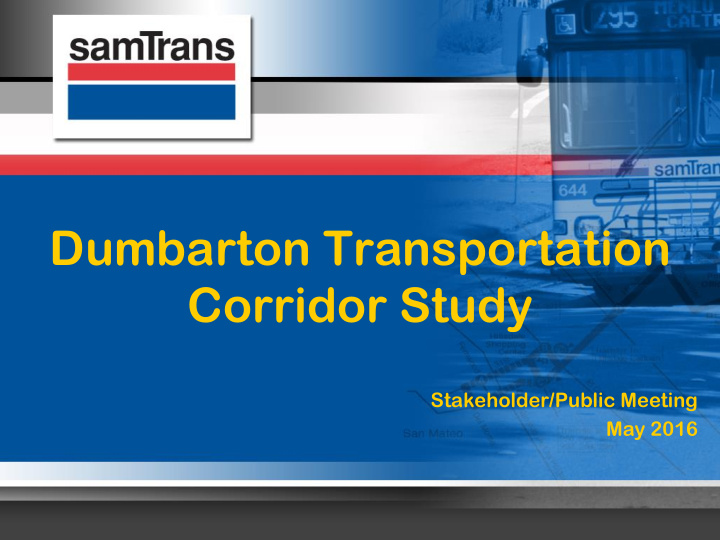



Dumbarton Transportation Corridor Study Stakeholder/Public Meeting May 2016
Dumbarton Corridor Source: Wikipedia 2
Transportation System 3
Bridge Use/Travel Markets • Almost 77,000 average daily trips • Work trips dominate transbay travel • Buses account for 5-6% of peak period use – Private shuttles account for 70% of bus ridership • Competitive travel markets: – Fremont to Palo Alto (including Stanford) – Ardenwood Park-and-Ride to Palo Alto 4
Growth Imbalance • Jobs-housing imbalance • Major employers driving growth • Congestion, lengthy and unpredictable travel times • Gaps in transportation network, limited options 5
Population • Higher density in East Palo Alto, Redwood City, Union City • Peninsula study area to increase by 200,000 people (25%) by 2040 • East Bay study area to increase by 155,000 (28%) by 2040 6
Employment • Existing higher density pockets in Fremont, Palo Alto, Redwood City • Peninsula “hot spots” • Peninsula study area jobs to increase by 140,000 (28%) by 2040 • East Bay study area jobs to increase by 62,000 (24%) by 2040 7
Background • Dumbarton Rail Corridor Alternatives Study completed in 2011 • Environmental review process on hold due to high costs and lack of funding • Bay Area has since experienced job growth, increased congestion and greater jobs-housing imbalance 8
Transportation Study • SamTrans to manage Study • Study partners: − SMCTA − ACTC − AC Transit − Facebook • 15-month schedule 9
Scope of Work • Study mobility improvements on rail bridge, highway bridge and approach arterials • Focus on short-term (2020) and long- term (2030) improvements and phasing Source: Wikipedia 10
Goals • Study operational and capital improvements that enhance mobility • Work with regional partners to expedite improvements • Assess how the rail bridge may be used, and make effective use of the transportation asset 11
Draft Evaluation Metrics • Average peak period travel times • Person throughput • Costs per user • Net capital cost • Qualitative risk score 12
Highway Bridge, Arterials • Short-Term • Long-Term − DBX Improvements − Bus lanes − Queue-jumps − Added general purpose lanes − Queue warning − Auxiliary lanes − Bus-only turn lanes − HOV 2+ or 3+ lanes − Signal coordination/ − Toll/express lanes transit signal priority − Metering lights − Direct access ramps − Lane use signs − Tolling policies − Variable speed limits − Autonomous vehicle lanes − Signage/wayfinding 13
Rail Bridge, ROW • Short-Term • Long-Term − Bike-pedestrian (West − Bike-pedestrian Bay) − Bus Rapid Transit − Light Rail Transit − Diesel/Electric Trains − Personal Rapid Transit Separate from bridge: − Hyperloop − Ferry − Gondola − Monorail 14
Next Steps • Screen initial alternatives • Further study short-list alternatives (e.g., conceptual engineering, ridership modeling) • Develop financial plan, consider Public- Private Partnerships • Recommend phasing 15
Outreach • Outreach at major milestones: − May 2016: Existing conditions, project goals and metrics, initial alternatives − September 2016: Initial alternatives screening, alternatives carried forward − April 2017: Evaluation of alternatives carried forward, funding plan, phasing plan 16
Study Process 17
Opportunities to Comment • Stakeholder/public meetings • Website: www.samtrans.com/DBCstudy • Email: reggiardom@samtrans.com • Telephone: 650-508-6283 • Mail: Attention Melissa Reggiardo, San Mateo County Transit District, P.O. Box 3006, 1250 San Carlos Avenue, San Carlos, 94070 18
Comments / Questions 19
Recommend
More recommend